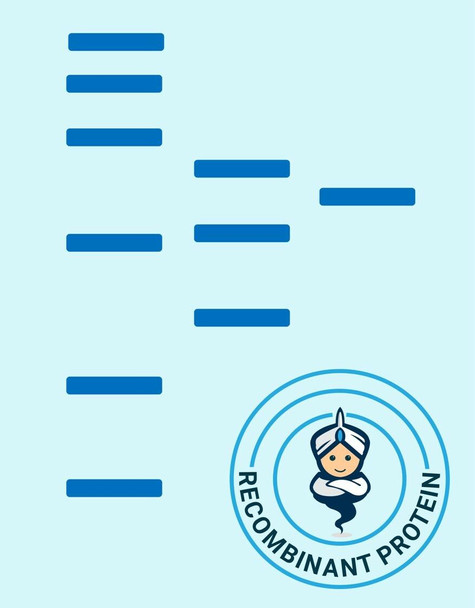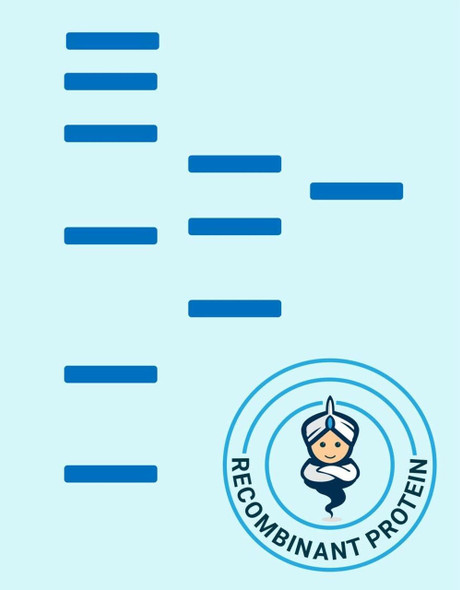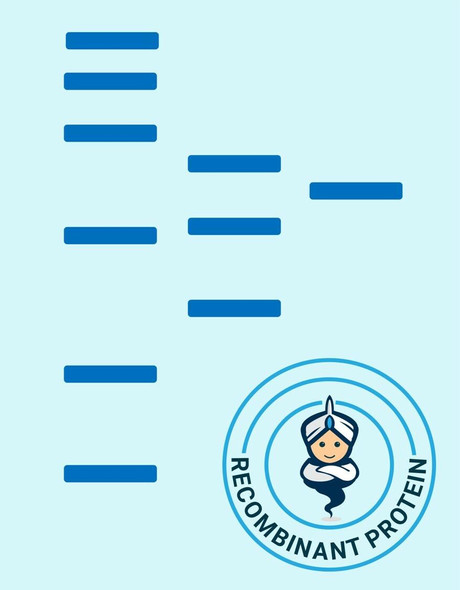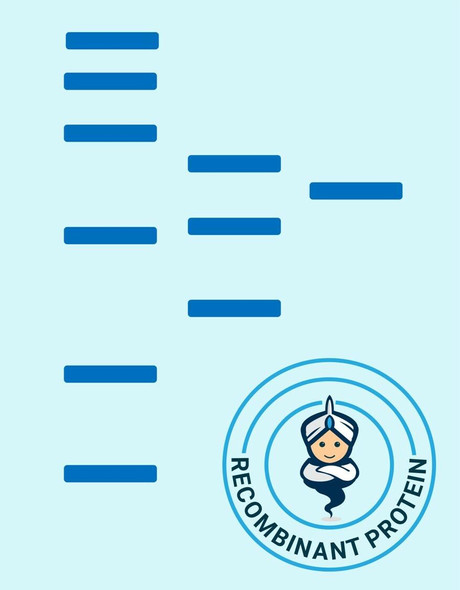Human PSMB10 Recombinant Protein (RPPB4322)
- SKU:
- RPPB4322
- Product Type:
- Recombinant Protein
- Species:
- Human
- Uniprot:
- P40306
- Research Area:
- Enzymes
Description
| Product Name: | Human PSMB10 Recombinant Protein |
| Product Code: | RPPB4322 |
| Size: | 5µg |
| Species: | Human |
| Target: | PSMB10 |
| Synonyms: | Proteasome subunit beta type-10, Low molecular mass protein 10, Macropain subunit MECl-1, Multicatalytic endopeptidase complex subunit MECl-1, Proteasome MECl-1, Proteasome subunit beta-2i, PSMB10, LMP10, MECL1, beta2i, MGC1665, FLJ00366. |
| Source: | Escherichia Coli |
| Physical Appearance: | Sterile Filtered colorless solution. |
| Formulation: | PSMB10 protein solution (0.25mg/ml) containing 20mM Tris-HCl buffer (pH8.0), 40% glycerol and 0.1M NaCl. |
| Stability: | Store at 4°C if entire vial will be used within 2-4 weeks. Store, frozen at -20°C for longer periods of time. For long term storage it is recommended to add a carrier protein (0.1% HSA or BSA).Avoid multiple freeze-thaw cycles. |
| Purity: | Greater than 90.0% as determined by SDS-PAGE. |
| Amino Acid Sequence: | MGSSHHHHHH SSGLVPRGSH MTTIAGLVFQ DGVILGADTR ATNDSVVADK SCEKIHFIAP KIYCCGAGVA ADAEMTTRMV ASKMELHALS TGREPRVATV TRILRQTLFR YQGHVGASLI VGGVDLTGPQ LYGVHPHGSY SRLPFTALGS GQDAALAVLE DRFQPNMTLE AAQGLLVEAVTAGILGDLGS GGNVDACVIT KTGAKLLRTL SSPTEPVKRS GRYHFVPGTT AVLTQTVKPL TLELVEETVQ AMEVE |
PSMB10 is a member of the proteasome B-type family (T1B family) which is a 20S core beta subunit. The proteasome is a multicatalytic proteinase complex with an extremely ordered ring-shaped 20S core structure. This core structure is comprised of four rings of 28 non-identical subunits; two rings are composed of seven alpha subunits and two rings are composed of seven beta subunits. Proteasomes are circulated in eukaryotic cells at a high concentration and cleave peptides in an ATP/ubiquitin-dependent process in a non-lysosomal pathway. A crucial function of a modified proteasome, the immunoproteasome, is the processing of class I MHC peptides. PSMB10 gene expression is induced by INFg, and it replaces catalytic subunit 2 (proteasome beta 7 subunit) in the immunoproteasome.
PSMB10 Human Recombinant produced in E.Coli is a single, non-glycosylated polypeptide chain containing 255 amino acids (40-273 a.a.) and having a molecular mass of 26.9kDa.PSMB10 is fused to a 20 amino acid His-tag at N-terminus & purified by proprietary chromatographic techniques.
| UniProt Protein Function: | PSMB10: The proteasome is a multicatalytic proteinase complex which is characterized by its ability to cleave peptides with Arg, Phe, Tyr, Leu, and Glu adjacent to the leaving group at neutral or slightly basic pH. The proteasome has an ATP-dependent proteolytic activity. This subunit is involved in antigen processing to generate class I binding peptides. Belongs to the peptidase T1B family. |
| UniProt Protein Details: | Protein type:EC 3.4.25.1; Protease; Proteasome complex Chromosomal Location of Human Ortholog: 16q22.1 Cellular Component: proteasome complex; nucleoplasm; proteasome core complex; cytosol Molecular Function:threonine endopeptidase activity Biological Process: positive regulation of ubiquitin-protein ligase activity during mitotic cell cycle; negative regulation of ubiquitin-protein ligase activity during mitotic cell cycle; protein polyubiquitination; viral reproduction; apoptosis; cell morphogenesis; antigen processing and presentation of exogenous peptide antigen via MHC class I, TAP-dependent; DNA damage response, signal transduction by p53 class mediator resulting in cell cycle arrest; humoral immune response; T cell proliferation; regulation of apoptosis; antigen processing and presentation of peptide antigen via MHC class I; regulation of ubiquitin-protein ligase activity during mitotic cell cycle; anaphase-promoting complex-dependent proteasomal ubiquitin-dependent protein catabolic process; antigen processing and presentation of exogenous peptide antigen via MHC class I; gene expression; mitotic cell cycle; regulation of amino acid metabolic process; G1/S transition of mitotic cell cycle; negative regulation of apoptosis |
| NCBI Summary: | The proteasome is a multicatalytic proteinase complex with a highly ordered ring-shaped 20S core structure. The core structure is composed of 4 rings of 28 non-identical subunits; 2 rings are composed of 7 alpha subunits and 2 rings are composed of 7 beta subunits. Proteasomes are distributed throughout eukaryotic cells at a high concentration and cleave peptides in an ATP/ubiquitin-dependent process in a non-lysosomal pathway. An essential function of a modified proteasome, the immunoproteasome, is the processing of class I MHC peptides. This gene encodes a member of the proteasome B-type family, also known as the T1B family, that is a 20S core beta subunit. Proteolytic processing is required to generate a mature subunit. Expression of this gene is induced by gamma interferon, and this gene product replaces catalytic subunit 2 (proteasome beta 7 subunit) in the immunoproteasome. [provided by RefSeq, Jul 2008] |
| UniProt Code: | P40306 |
| NCBI GenInfo Identifier: | 730376 |
| NCBI Gene ID: | 5699 |
| NCBI Accession: | P40306.1 |
| UniProt Secondary Accession: | P40306,Q5U098, B2R5J4, |
| UniProt Related Accession: | P40306 |
| Molecular Weight: | 273 |
| NCBI Full Name: | Proteasome subunit beta type-10 |
| NCBI Synonym Full Names: | proteasome (prosome, macropain) subunit, beta type, 10 |
| NCBI Official Symbol: | PSMB10�� |
| NCBI Official Synonym Symbols: | LMP10; MECL1; beta2i�� |
| NCBI Protein Information: | proteasome subunit beta type-10; proteasome MECl-1; macropain subunit MECl-1; proteasome subunit MECL1; proteasome subunit beta 7i; proteasome subunit beta-2i; low molecular mass protein 10; proteasome catalytic subunit 2i; multicatalytic endopeptidase complex subunit MECl-1 |
| UniProt Protein Name: | Proteasome subunit beta type-10 |
| UniProt Synonym Protein Names: | Low molecular mass protein 10; Macropain subunit MECl-1; Multicatalytic endopeptidase complex subunit MECl-1; Proteasome MECl-1; Proteasome subunit beta-2i |
| Protein Family: | Proteasome |
| UniProt Gene Name: | PSMB10�� |
| UniProt Entry Name: | PSB10_HUMAN |










